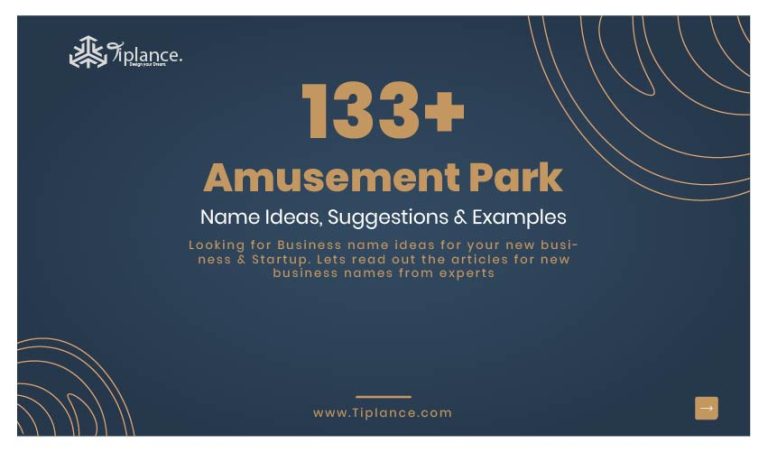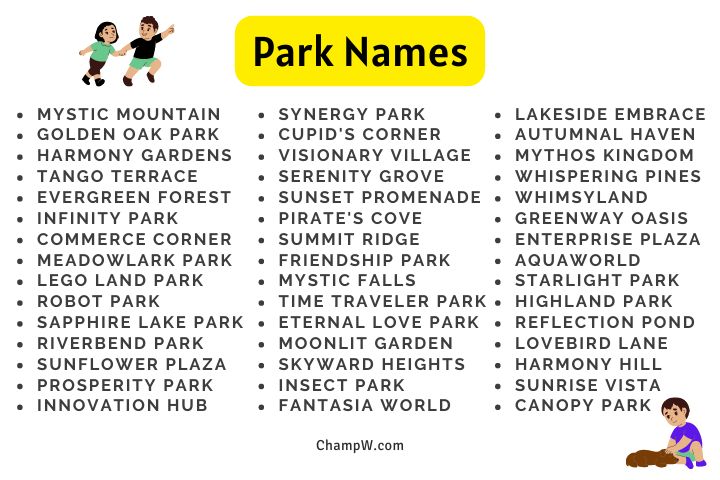How to Brainstorm a Theme Park Name that Attracts Visitors
When it comes to creating an unforgettable theme park experience, the name of the park is often the first impression that potential visitors receive. A well-chosen theme park name can convey the park’s unique theme, tone, and atmosphere, setting the stage for an exciting and memorable experience. On the other hand, a poorly chosen name can fall flat and fail to attract visitors. That’s why brainstorming ideas for a theme park name is such a crucial part of the park’s development process.
So, where do you start when brainstorming ideas for a theme park name? One approach is to think about the park’s theme and tone. What kind of experience do you want to create for your visitors? Is it a thrilling adventure, a family-friendly outing, or an educational experience? Once you have a clear idea of the park’s theme and tone, you can start generating name ideas that fit with that vision.
Another approach is to think about the park’s target audience. Who are the people that you want to attract to your park? Are they families with young children, thrill-seekers, or fans of a particular movie or TV show? By thinking about the demographics and interests of your target audience, you can generate name ideas that will resonate with them and make them more likely to visit the park.
Some other tips for brainstorming ideas for a theme park name include using wordplay and puns, incorporating the park’s location or environment, and using alliteration and rhyme to make the name more memorable. You can also try to come up with a name that incorporates the park’s unique features or attractions, such as a roller coaster or a water park.
Ultimately, the key to brainstorming a great theme park name is to be creative and think outside the box. Don’t be afraid to try out different ideas and see what works best for your park. With a little bit of imagination and a lot of brainstorming, you can come up with a theme park name that will attract visitors and create an unforgettable experience.
Theme Park Name Ideas Inspired by Popular Culture
Popular culture has long been a source of inspiration for theme park names. From movies and TV shows to books and video games, there are countless examples of theme parks that have successfully leveraged popular culture in their naming. One notable example is Universal Studios’ “Wizarding World of Harry Potter”, which has become a huge draw for fans of the beloved book and film series.
Another example is Disneyland’s “Star Wars: Galaxy’s Edge”, which has brought the magic of the Star Wars franchise to life in a highly immersive and interactive way. By incorporating elements of popular culture into their naming, theme parks can tap into the existing fan base and create a sense of excitement and anticipation among potential visitors.
Other examples of theme parks that have successfully used popular culture in their naming include “The Walking Dead” themed areas at Universal Studios and Six Flags, and the “Sesame Street” themed area at SeaWorld. These names not only appeal to fans of the respective franchises but also provide a sense of familiarity and comfort, making visitors more likely to feel at home in the park.
When it comes to ideas for a theme park name inspired by popular culture, the possibilities are endless. Theme parks can draw inspiration from movies, TV shows, books, video games, and even music. The key is to choose a franchise or property that aligns with the park’s theme and tone, and to incorporate elements of that franchise into the naming in a way that feels authentic and engaging.
Some other popular culture-inspired theme park name ideas might include “The Lord of the Rings: Middle-earth Adventure”, “The Hunger Games: Panem Park”, or “The Marvel Universe: Superhero City”. These names not only evoke a sense of excitement and adventure but also provide a sense of depth and richness, suggesting a highly immersive and interactive experience.
Using Wordplay and Puns to Create a Memorable Theme Park Name
Wordplay and puns can be a powerful tool in creating a memorable theme park name. By using clever language and clever turns of phrase, theme parks can create a name that is both fun and memorable. One example of a theme park that has successfully used wordplay in its naming is Legoland, which combines the words “lego” and “land” to create a name that is both catchy and descriptive.
Another example is SeaWorld, which uses a play on words to create a name that is both fun and memorable. The use of “sea” and “world” creates a sense of scope and scale, while also evoking the idea of a fantastical and exciting place.
Other examples of theme parks that have successfully used wordplay in their naming include “Dollywood”, which combines the name of Dolly Parton with the word “Hollywood” to create a name that is both fun and memorable, and “Silver Dollar City”, which uses a play on words to create a name that is both catchy and descriptive.
When it comes to using wordplay and puns in theme park naming, the key is to be creative and have fun with it. Theme parks can use a variety of techniques, such as combining words, using alliteration and rhyme, and creating clever turns of phrase. By using wordplay and puns, theme parks can create a name that is both memorable and engaging, and that will appeal to visitors of all ages.
Some other ideas for theme park names that use wordplay and puns include “Thrillville”, “Adventureland”, and “Funtopia”. These names use a combination of words and clever turns of phrase to create a sense of excitement and adventure, and are sure to appeal to visitors who are looking for a fun and memorable experience.
When brainstorming ideas for a theme park name, it’s a good idea to think about the tone and atmosphere of the park, and to use wordplay and puns to create a name that reflects that tone and atmosphere. By using clever language and clever turns of phrase, theme parks can create a name that is both fun and memorable, and that will appeal to visitors of all ages.
Theme Park Name Ideas that Reflect the Park’s Location or Environment
When it comes to choosing a theme park name, one approach is to reflect the park’s location or environment. This can be a great way to create a sense of place and authenticity, and to help visitors understand what to expect from their visit. For example, Disneyland in California is named after its location in Anaheim, California, and the name has become synonymous with the park’s iconic theme and attractions.
Another example is Busch Gardens, which is named after the Anheuser-Busch brewery that was once located on the site. The name reflects the park’s location in Tampa, Florida, and its history as a brewery and animal sanctuary. By incorporating the location or environment into the name, theme parks can create a sense of connection to the local community and culture.
Other examples of theme parks that have successfully incorporated their location or environment into their naming include “Lake Compounce” in Connecticut, which is named after the lake that the park is situated on, and “Dollywood” in Tennessee, which is named after Dolly Parton’s hometown of Sevierville.
When brainstorming ideas for a theme park name that reflects the park’s location or environment, consider the following tips:
Look to the local culture and history for inspiration. Consider the park’s location, geography, and natural features. Think about how the park’s environment can be incorporated into the name. Use words or phrases that evoke a sense of place and authenticity.
Some other ideas for theme park names that reflect the park’s location or environment include “Mountain Adventure Park”, “Coastal Cove”, and “Desert Oasis”. These names use words or phrases that evoke a sense of place and environment, and can help to create a sense of excitement and adventure for visitors.
By incorporating the location or environment into the name, theme parks can create a sense of connection to the local community and culture, and can help to differentiate themselves from other parks. Whether it’s a reference to a local landmark, a nod to the park’s history, or a reflection of the park’s natural environment, a well-chosen name can help to create a lasting impression on visitors.
Creating a Theme Park Name that Appeals to a Specific Demographic
When it comes to creating a theme park name, it’s essential to consider the target audience and tailor the name to appeal to that demographic. Different age groups, interests, and cultural backgrounds can influence the type of name that will resonate with visitors. For example, a theme park aimed at families with young children might choose a name that is playful and fun, such as “Wonderland” or “Fantasy Land”.
On the other hand, a theme park aimed at thrill-seekers might choose a name that is more edgy and exciting, such as “Adrenaline Park” or “Thrillville”. By understanding the target audience and tailoring the name to appeal to that demographic, theme parks can create a name that resonates with visitors and sets the tone for an unforgettable experience.
Some other tips for creating a theme park name that appeals to a specific demographic include:
Researching the target audience and understanding their interests and preferences. Using language and imagery that resonates with the target audience. Creating a name that is memorable and easy to pronounce. Avoiding names that may be off-putting or confusing to the target audience.
For example, a theme park aimed at families with young children might avoid using names that are too scary or intense, while a theme park aimed at thrill-seekers might avoid using names that are too tame or boring. By understanding the target audience and tailoring the name to appeal to that demographic, theme parks can create a name that sets the tone for an unforgettable experience.
Some other ideas for theme park names that appeal to specific demographics include:
“Kids’ Kingdom” for a theme park aimed at families with young children. “Thrilltopia” for a theme park aimed at thrill-seekers. “Adventureland” for a theme park aimed at families with older children and teenagers. “Senior Safari” for a theme park aimed at seniors and retirees.
By tailoring the name to appeal to a specific demographic, theme parks can create a name that resonates with visitors and sets the tone for an unforgettable experience.
Using Alliteration and Rhyme to Make a Theme Park Name More Memorable
Alliteration and rhyme are powerful tools in creating a memorable theme park name. By using words that start with the same sound or have a similar sound, theme parks can create a name that is both fun and memorable. For example, “Six Flags” is a well-known theme park name that uses alliteration to create a catchy and memorable name.
Another example is “Cedar Point”, which uses a combination of alliteration and rhyme to create a name that is both fun and memorable. The use of “C” and “P” sounds creates a sense of rhythm and flow, making the name more memorable and engaging.
Other examples of theme parks that have successfully used alliteration and rhyme in their naming include “Disney’s Dreamland” and “Universal’s Universe of Fun”. These names use a combination of alliteration and rhyme to create a sense of excitement and adventure, making them more memorable and engaging for visitors.
When using alliteration and rhyme in theme park naming, it’s essential to consider the following tips:
Use words that start with the same sound or have a similar sound. Create a sense of rhythm and flow by using words that have a similar syllable count or stress pattern. Avoid using alliteration and rhyme in a way that sounds forced or artificial. Use alliteration and rhyme to create a sense of excitement and adventure.
Some other ideas for theme park names that use alliteration and rhyme include:
“Funland Frenzy” for a theme park that focuses on thrill rides and attractions. “Adventureland Adventures” for a theme park that focuses on adventure and exploration. “Wonderworld Wonders” for a theme park that focuses on wonder and discovery.
By using alliteration and rhyme in theme park naming, theme parks can create a name that is both fun and memorable, making it more likely to attract visitors and create a lasting impression.
Theme Park Name Ideas that Incorporate the Park’s Unique Features or Attractions
Incorporating the park’s unique features or attractions into the name can be a great way to create a memorable and distinctive theme park name. For example, “Universal’s Islands of Adventure” incorporates the park’s unique feature of having multiple themed islands, while “Knott’s Berry Farm” incorporates the park’s unique attraction of being a working farm.
Other examples of theme parks that have successfully incorporated their unique features or attractions into their naming include “Disney’s Animal Kingdom” and “SeaWorld’s Discovery Cove”. These names not only convey the park’s unique theme and attractions but also create a sense of excitement and adventure.
When incorporating the park’s unique features or attractions into the name, consider the following tips:
Identify the park’s unique features or attractions. Use language that is descriptive and evocative. Create a sense of excitement and adventure. Avoid using names that are too long or complicated.
Some other ideas for theme park names that incorporate the park’s unique features or attractions include:
“Thrillville” for a theme park that focuses on thrill rides and attractions. “Waterworld” for a theme park that focuses on water-based attractions. “Adventureland” for a theme park that focuses on adventure and exploration.
By incorporating the park’s unique features or attractions into the name, theme parks can create a name that is both memorable and distinctive, making it more likely to attract visitors and create a lasting impression.
Final Tips for Choosing a Theme Park Name that Works
Choosing a theme park name that works requires careful consideration and testing. Here are some final tips to help you choose a name that will attract visitors and create a lasting impression:
Test the name with potential visitors. Conduct surveys or focus groups to gather feedback on the name and make adjustments as needed. Ensure the name is easy to remember and pronounce. Avoid names that are too long or complicated. Consider the brand identity and overall image of the park. Ensure the name aligns with the park’s unique theme, tone, and atmosphere.
Some other ideas for theme park names that incorporate these tips include:
“Thrilltopia” for a theme park that focuses on thrill rides and attractions. “Wonderland” for a theme park that focuses on wonder and discovery. “Adventureland” for a theme park that focuses on adventure and exploration.
By following these tips and considering the unique features and attractions of your theme park, you can choose a name that will attract visitors and create a lasting impression.
Remember, the name of your theme park is the first impression that potential visitors will have of your park. Make it count by choosing a name that is memorable, easy to pronounce, and aligns with the park’s unique theme, tone, and atmosphere.








